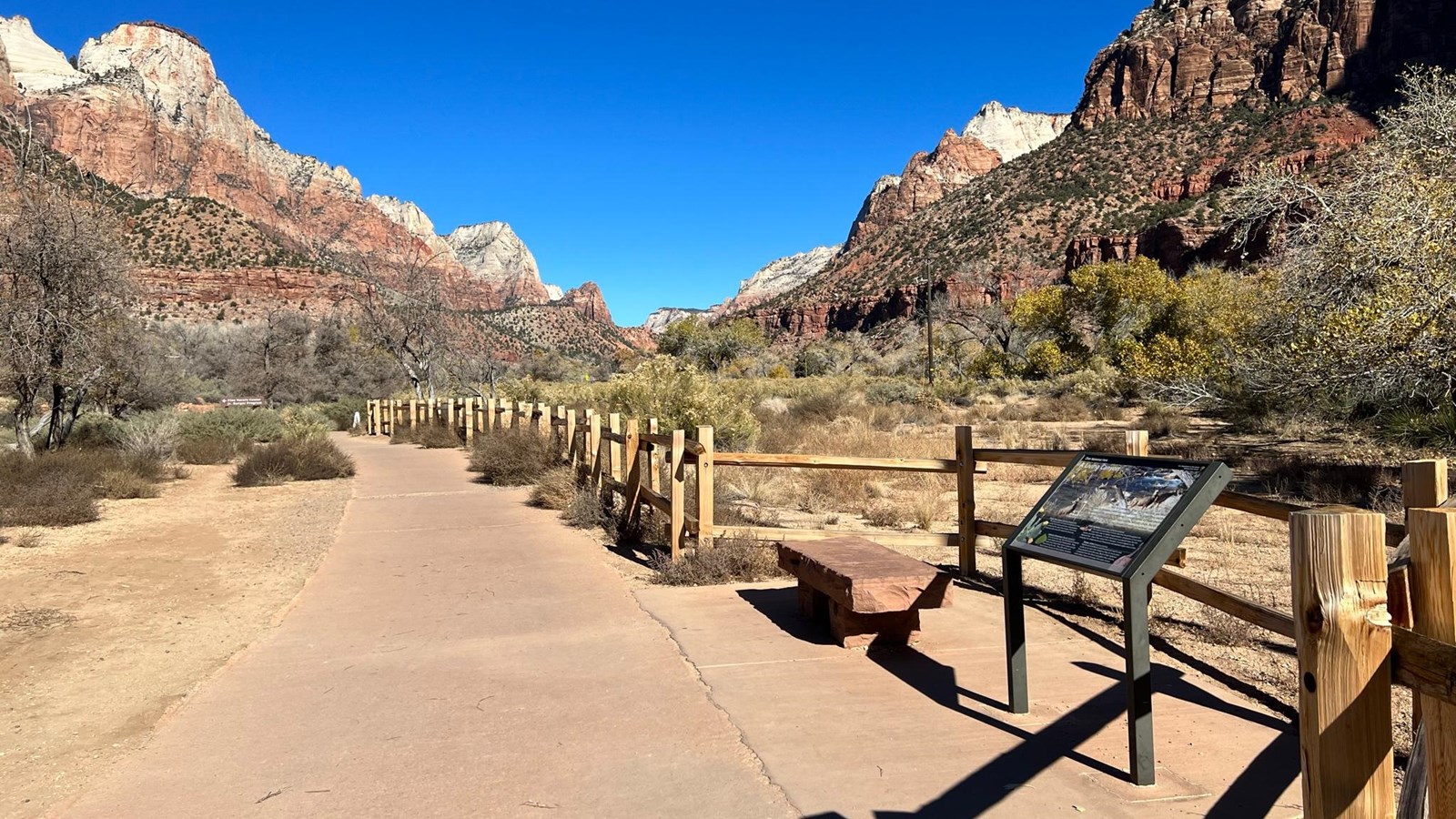Last updated: April 2, 2025
Place
Pa'rus - A Living Canyon

NPS/Abi Farish
Historical/Interpretive Information/Exhibits, Pets Allowed, Scenic View/Photo Spot, Wheelchair Accessible
A Living Canyon
Learn
Zion's diverse topography leads to a diversity of habitats and species. Along the Virgin River, the riparian area is home to plants and animals that require an abundant supply of water.
Fremont cottonwood trees (Populus fremontii) require a constant source of water and thrive along the Virgin River. When Fremont cottonwoods have access to reliable water, they can grow between 10–20 feet per year. These trees can also be helpful for streambank protection and are able to withstand low levels of flooding.
The riparian area is also the perfect habitat for the American beaver. You may not immediately think of the American beaver when in the Southwest, but the Virgin River provides a welcome habitat for this river specialist. Sightings are rare, but evidence of the beaver's activity can be seen on many of the park's Fremont cottonwood trees. They do most of their tree-chewing during the night when the cover of darkness helps them to avoid predators.
Look
Have you seen any evidence of wildlife along the trail? The tall shrubs and plants along the trail like Utah Juniper and Rabbitbrush provide food and shelter for a variety of mammals, birds, and reptiles. Along the trail keep an eye out for wildlife like mule deer, road runner, and western scrub jays.
Connect
Zion Canyon would be inhospitable for plants and wildlife without water. How would our experience as visitors change if there were no water present in Zion Canyon?Transcript
1
00:00:05,455 --> 00:00:06,289
Hello.
2
00:00:06,289 --> 00:00:07,340
I'm Ranger Nicholas,
3
00:00:07,340 --> 00:00:09,642
and I'm standing here
on the Pa’rus trail
4
00:00:09,642 --> 00:00:12,278
next to a sign
titled A Living Canyon.
5
00:00:12,278 --> 00:00:14,514
Now, when you think of Zion,
you might envision
6
00:00:14,514 --> 00:00:17,467
the towering cliffs
that form the canyon walls,
7
00:00:17,467 --> 00:00:19,386
but equally important
to the natural beauty
8
00:00:19,386 --> 00:00:22,389
here is the abundance of plant
and animal life.
9
00:00:22,956 --> 00:00:25,141
Both exist
because of the presence of water
10
00:00:25,141 --> 00:00:28,144
sources like the Virgin River,
which this trail follows.
11
00:00:28,378 --> 00:00:29,312
The water that the river
12
00:00:29,312 --> 00:00:33,516
supplies supports the diverse
riparian or riverside ecosystem
13
00:00:33,516 --> 00:00:34,417
in the canyon.
14
00:00:34,417 --> 00:00:37,904
And the Virgin River itself
hosts many flood adapted fishes
15
00:00:38,088 --> 00:00:39,889
and amphibian species.
16
00:00:39,889 --> 00:00:42,125
Animals require
constant access to water.
17
00:00:42,125 --> 00:00:44,094
Just like the plants
that live in this area.
18
00:00:44,094 --> 00:00:46,012
Like the Fremont cottonwoods.
19
00:00:46,012 --> 00:00:49,432
These plants, in turn, provide
food and habitat for the animals
20
00:00:49,432 --> 00:00:51,735
that live here. As you
stroll the trail,
21
00:00:51,735 --> 00:00:54,821
keep an eye out for mule deer
grazing in the rabbit brush.
22
00:00:55,038 --> 00:00:57,907
Or porcupines
resting high in the trees.
23
00:00:57,907 --> 00:00:58,608
I encourage you
24
00:00:58,608 --> 00:01:01,878
to take some time to stop,
look and listen for wildlife.
25
00:01:02,112 --> 00:01:05,115
And always remember
to give them plenty of space.
26
00:01:05,415 --> 00:01:06,282
Thanks for joining me
27
00:01:06,282 --> 00:01:09,402
as you hike today and learning
more about Zion National Park.
- Duration:
- 1 minute, 10 seconds
Ranger Nick talks about the connection between water, plants, and wildlife in Zion!
